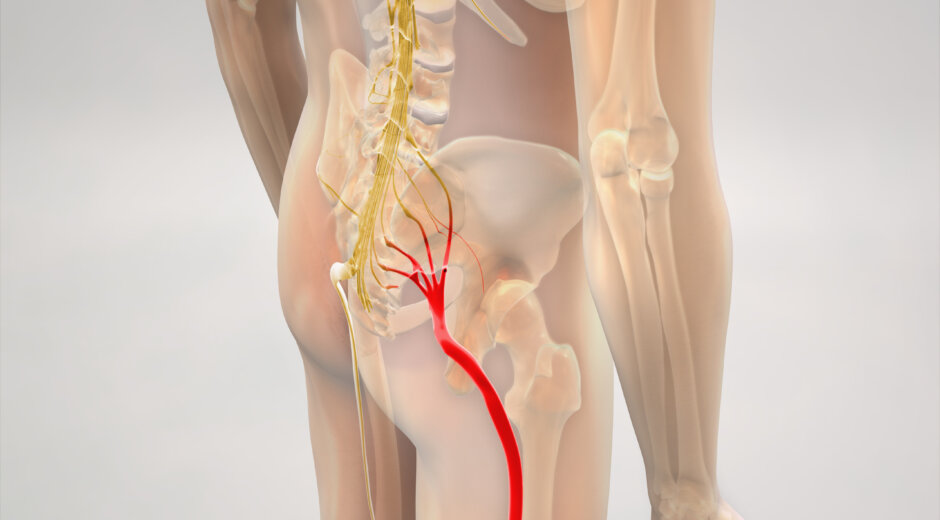Almost half of Americans experience sciatic pain at some point in their life. Find relief with these 7 yoga poses for sciatica. Learn how to do each pose with easy-to-follow video tutorials for Cat ~ Cow, Child’s, Cobra, Locust, Down Dog, Half Moon, and Bridge poses.
What is Sciatica?
On each side of your body, the sciatic nerve runs through your hips, buttocks, and leg, ending just below the knee. This nerve then branches into other nerves, which continue down the leg and into the foot and toes. The sciatic nerve is the largest and longest nerve in the body so it’s easy to imagine that when this nerve is irritated it is a big deal.
The term ‘sciatica’ describes pain that originates in the lower (lumbar) spine and radiates through the hips, buttocks, and/or down the leg. This pain can run down one or both sides of the body and can be caused by any irritation, inflammation, pinching, or compression of the lower back nerve. Common causes are herniated discs or a bone spur on the vertebrae. Sciatica pain can be sharp, shooting, burning, or stabbing, usually reoccurring. Pain can radiate from anywhere on this nerve path but commonly it is from the low back to the buttock and back of the thigh. Numbness and tingling are also associated with sciatica. None of that sounds pleasant. One of the markers of good quality of life is to have a healthy body that is pain-free and yoga is the tune-up that your body needs.
Causes of Sciatica
So what causes sciatic pain? The risk factors include:
- Osteoarthritis – Osteoarthritis of the spine can lead to lost flexibility, bone spurs (osteophytes), irritated nerves, spinal stenosis, and sciatica.
- Previous injury to low back or spine.
- Prolonged sitting – Sitting for extended periods of time can create muscular imbalances in your posterior chain, which can lead to inflammation that could compress your sciatic nerve.
- Lacking strong core – When your core is weak, the abdominal and lower back muscles do not properly support the spine, as a result, there is increased pressure on the spine causing subluxations, and irritating or pinching the sciatic nerves.
- Being overweight – The spine supports the body’s weight so the more body weight, the more pressure on it. This can cause extra pressure on the sciatic nerve. Currently, about 70% of Americans are overweight.
Sciatica and Pregnancy
Sciatica is common in pregnancy but not necessarily due to weight gain. Ligaments that hold the vertebrae, disks, and spine in place become loosened by pregnancy hormones. This can destabilize the spine which could lead to pinching of nerves and the onset of sciatica. Sciatica during pregnancy is one thing but sciatica during labor brings more challenges. It can limit the positions that you are able to be in, making birth more difficult. Prenatal yoga for sciatica is highly recommended as many yoga poses take the pressure off the sciatic nerve and therefore relieve the pain.
How to Prevent Sciatica
The key to preventing sciatica is back care! There are so many moving parts in the back so it is important that we take care of it to ensure that it takes care of us. How do we protect our back?
- Consistent Exercise – Developing and maintaining a strong core (the muscles not only of the abdomen but also of the lower back) is vital for correct posture and proper alignment.
- Yoga – A gentle yoga practice has been shown to be ideal for relieving sciatic pain. Easy stretches combined with relaxed slowed breathing works as an effective body/mind therapy.
- Proper Sitting Posture – Many of us sit at a desk all day while working or studying, so the chair you sit in is important. Maintain an upright posture without slouching for good spine health.
- Good Body Mechanics – When lifting anything heavy use your lower body to do the work and this movement will protect the spine. Hold the load close to the body. Avoid lifting and twisting at the same time.
Yoga Poses for Sciatica
Yoga is perfect for low back issues and sciatica. The movements are mindful and slow. Yoga poses stretch and strengthen the muscles and it is low impact. Poses that stretch the hip flexor muscles, the hamstrings, and the glutes are excellent for low back issues and sciatic pain because in working those muscles you will also stretch the low back muscles. An NHI study showed that participants reported a greater decrease in pain when adding a 12-week yoga program to their usual back pain care. Practice along with these videos and learn proper alignment for these 7 yoga poses for sciatica. A prescription for yoga for sciatica pain is just what the doctor ordered!
Share the Love
With 40% of Americans experiencing sciatic pain at some point, there’s a good chance someone you love could benefit from this knowledge. Please share and help someone today.


Write Your Comment
Leave a comment